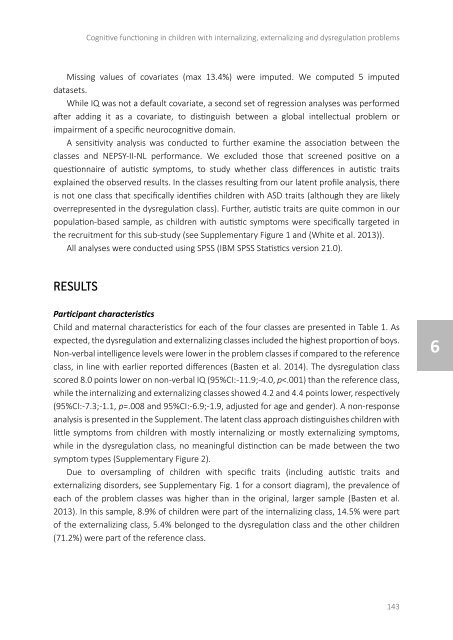On the Spectrum
2lm5UyR
2lm5UyR
Create successful ePaper yourself
Turn your PDF publications into a flip-book with our unique Google optimized e-Paper software.
Cognitive functioning in children with internalizing, externalizing and dysregulation problems<br />
Missing values of covariates (max 13.4%) were imputed. We computed 5 imputed<br />
datasets.<br />
While IQ was not a default covariate, a second set of regression analyses was performed<br />
after adding it as a covariate, to distinguish between a global intellectual problem or<br />
impairment of a specific neurocognitive domain.<br />
A sensitivity analysis was conducted to fur<strong>the</strong>r examine <strong>the</strong> association between <strong>the</strong><br />
classes and NEPSY-II-NL performance. We excluded those that screened positive on a<br />
questionnaire of autistic symptoms, to study whe<strong>the</strong>r class differences in autistic traits<br />
explained <strong>the</strong> observed results. In <strong>the</strong> classes resulting from our latent profile analysis, <strong>the</strong>re<br />
is not one class that specifically identifies children with ASD traits (although <strong>the</strong>y are likely<br />
overrepresented in <strong>the</strong> dysregulation class). Fur<strong>the</strong>r, autistic traits are quite common in our<br />
population-based sample, as children with autistic symptoms were specifically targeted in<br />
<strong>the</strong> recruitment for this sub-study (see Supplementary Figure 1 and (White et al. 2013)).<br />
All analyses were conducted using SPSS (IBM SPSS Statistics version 21.0).<br />
RESULTS<br />
Participant characteristics<br />
Child and maternal characteristics for each of <strong>the</strong> four classes are presented in Table 1. As<br />
expected, <strong>the</strong> dysregulation and externalizing classes included <strong>the</strong> highest proportion of boys.<br />
Non-verbal intelligence levels were lower in <strong>the</strong> problem classes if compared to <strong>the</strong> reference<br />
class, in line with earlier reported differences (Basten et al. 2014). The dysregulation class<br />
scored 8.0 points lower on non-verbal IQ (95%CI: -11.9;-4.0, p


